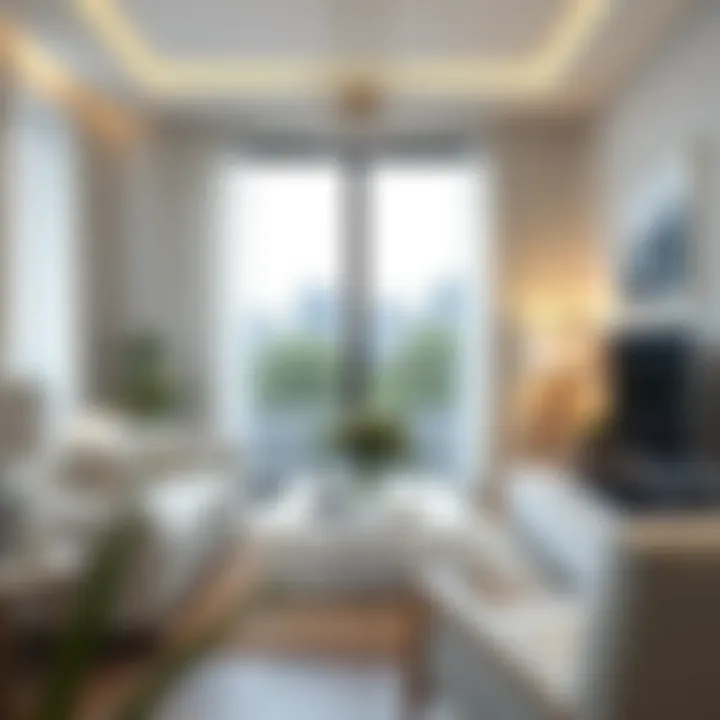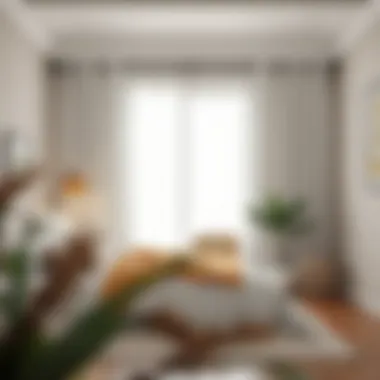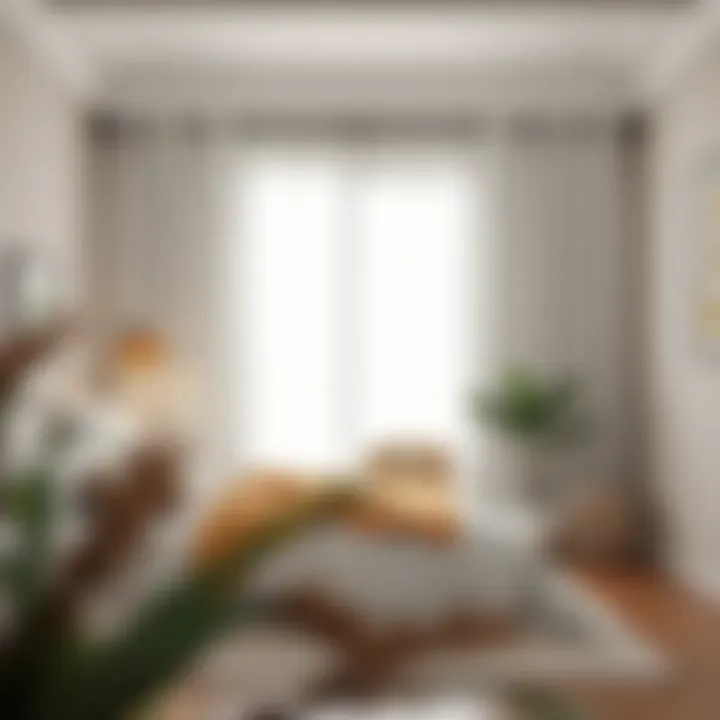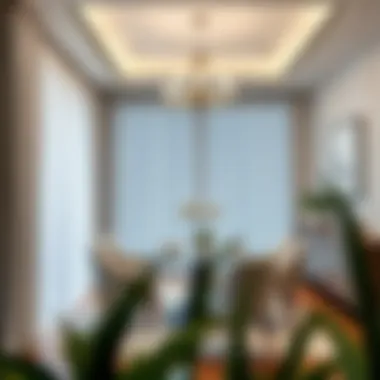Exploring the Role of White Geometric Curtains in Modern Interiors


Intro
In the realm of contemporary interior design, the subtleties of fabric choices often dictate the ambiance of a space. Enter the world of white geometric curtains, where simplicity and sophistication find common ground. Not only do these curtains serve as functional items, controlling light and privacy, but they also act as essential elements that can elevate the overall aesthetic of modern homes. Their clean lines and versatile patterns make them a favorite among homeowners and decorators alike.
Understanding how such curtains fit into a cohesive design scheme can transform everyday spaces from mundane to remarkable. This article endeavors to dissect the significance of white geometric curtains, examining styles, patterns, and practical tips to guide your selection process. By the end of this exploration, you will gain insights that extend beyond mere decoration.
Furniture Styles and Trends
Exploring Popular Furniture Styles
Home furnishings play a vital role in complementing window treatments. With an ever-changing landscape of styles, it’s imperative to find the right balance. Imagine a living space dominated by mid-century modern furniture; the clean lines and organic shapes paired with a crisp white geometric curtain provide a stunning visual contrast. Likewise, a cozy Shabby Chic setting benefits from the airy nature of white curtains layered over floral printed textiles.
Conversely, when dealing with the minimalist aesthetic, the choice of furniture should harmonize with the bold statements made by geometric patterns. Opting for neutral-toned furniture allows these curtains to take center stage without overwhelming the senses.
Understanding Current Design Trends
Currently, there’s a growing emphasis on transitional design, marrying traditional with contemporary. White geometric curtains fit snugly into this trend, providing needed flexibility. With so many geometric designs available—from sharp angles to softer curves—you can find a style that resonates with your personal taste.
In recent years, eco-friendly materials have surged in popularity. Many manufacturers are now offering curtains made from sustainable fabrics that not only contribute to a stylish environment but are also gentle on the planet. This aligns well with the eco-conscious design trends prevailing in today's market.
Practical Tips for Furniture Selection
Factors to Consider When Choosing Furniture
When selecting furniture to accompany white geometric curtains, consider the following:
- Color Palette: Ensure that the shades of your furniture complement the white of the curtains.
- Textures: Mixing textures can add depth. Wooden furniture with soft fabric can create a well-rounded look.
- Scale and Proportion: Choose furniture that matches the scale of your space, as too large or too small can disrupt harmony.
How to Measure and Optimize Space
To maximize a room's potential, it's crucial to measure meticulously before purchasing furniture. Use the following tips:
- Take Accurate Measurements: Assess the height and width of spaces where you intend to place curtains and furniture.
- Visualize Layouts: Utilize design apps to create virtual layouts; it’s a realistic way to envision how items will interact within your space.
- Balance is Key: Avoid clutter by ensuring adequate pathways around furniture while allowing curtains room to fall freely.
End
Preamble to White Geometric Curtains
White geometric curtains have carved a niche in contemporary interior design, intertwining function with aesthetics in a way that speaks to both homeowners and design professionals alike. Their importance is underscored by several key factors that appeal to various personal tastes and practical needs. First off, the color white embodies a sense of cleanliness and minimalism, encapsulating the essence of modern design. When juxtaposed with geometric patterns, it introduces an element of sophistication that can elevate any space.
These curtains do not merely serve the purpose of blocking light or ensuring privacy. They create a canvas upon which the rest of the room's décor can play. For instance, in a vibrant living space filled with bold colors, white geometric curtains can act as a breath of fresh air, softening the visual impact while still maintaining a strong stylistic presence. The patterns themselves—be they stripes, diamonds, or more intricate shapes—offer versatility, allowing them to align with various design themes from minimalism to eclecticism.
When considering white geometric curtains, homeowners and decorators must weigh several elements. Material choice is paramount as it influences both the aesthetic quality and the practical functionality of the curtains. Fabrics like linen or cotton not only add texture but also allow the geometric designs to breathe, making them visually appealing from various angles and in different light conditions.
Another benefit worth mentioning is their ability to harmonize with other decor elements. Whether it's a sleek modern room with cold metals and sharp lines or a cozy, bohemian space filled with textiles, white geometric curtains can elegantly tie together disparate design elements, creating a coherent look that feels thoughtfully curated.
Ultimately, the appeal of white geometric curtains lies in their duality—they enhance a space's tranquility while simultaneously injecting a spirited design element. Their multifunctional role underscores a core aspect of interior design: every piece counts, and thoughtful selections contribute to the overall experience in a room.
"In the realm of design, simplicity is often the ultimate sophistication."
In summation, the introduction of white geometric curtains into the modern home is not merely about fabric; it's a decision that resonates through the atmosphere, affecting mood and showcasing style. To explore the possibilities of incorporating these stylish elements further, let's look into the historical context of geometric patterns.
Historical Context of Geometric Patterns
Understanding the historical context of geometric patterns provides a backdrop for appreciating their relevance in contemporary design, especially in the case of white geometric curtains. Throughout history, geometric designs have served various purposes—from symbolic meanings in ancient civilizations to the aesthetic choices seen in modern interiors. Recognizing these layers of meaning can enhance how we perceive and elevate our spaces with these unique draperies.
Evolution of Geometric Design in Textiles
The journey of geometric patterns in textiles is both rich and varied. Starting from the intricate carpet designs of Persia to the minimalist Scandinavian prints that emerged in the 20th century, geometric graphics have adapted, shifted, and evolved in response to cultural changes and technological advancements.
In ancient Egypt, for example, geometric motifs were used not merely as decorative elements but as visual storytelling tools, reflecting the significance of order and harmony in society. Fast forward to the 1960s, and geometric patterns underwent a radical transformation. Influenced by the rise of modernism, designs became bold, vibrant, and abstract, capturing the spirit of an age that was all about breaking the mold. The use of geometric patterns in curtains, particularly white ones, gained traction as a way to embody the simplicity and clarity of modern design aesthetics.
Benefits of Understanding Design Evolution:


- Informed Choices: Knowing the roots of geometric patterns can guide homeowners and designers in selecting curtains that do not just fit a trend but also resonate with traditional artistry.
- Design Synergy: Recognizing how geometric shapes have been incorporated into various cultural contexts allows for a harmonious blend of styles in one’s space.
Cultural Influences on Geometric Patterns
The cultural tapestry of our world displays a myriad of influences that have shaped geometric patterns through time. In various cultures, geometric designs have not just decorative value but also deep-seated meanings.
Take the Islamic art tradition, which avoids representational imagery and instead emphasizes complex geometric patterns, reflecting principles of unity and infinity. This contrasts with Western designs that often draw from nature. Each approach carries its philosophical weight, thereby informing how these patterns can express different narratives based on their use.
Considerations When Integrating Cultural Geometric Designs:
- Authenticity: Choosing designs that genuinely reflect cultural heritage can create a deep connection in the room’s atmosphere.
- Contrast and Balance: By pairing geometric curtains with soft furnishings that celebrate organic shapes, one can achieve a balanced aesthetic that honors both tradition and modernity.
The intersection of history and culture in geometric patterns reveals the multidimensionality of design, rendering it a compelling choice for spaces that seek to balance functionality with narrative depth.
Defining Characteristics of White Geometric Curtains
Understanding the defining characteristics of white geometric curtains is key for anyone looking to elevate their living spaces with a modern touch. These curtains, often seen as mere fabric on a rod, embody both aesthetic appeal and function. They blend elegance with a contemporary edge, making them a versatile choice, whether one seeks simplicity or wants a bold statement.
More than just a pretty face, white geometric curtains provide a canvas for light manipulation, texture, and ambiance in any room. The characteristics that dominate this category combine elements like material, pattern, and cultural relevance. Each aspect plays a significant role in how these curtains affect the atmosphere and functionality of a home.
Material Choices and Their Impact
Selecting the material for white geometric curtains can make or break the overall look of a room. The choices available range from sheer linens to heavier fabrics like canvas or brocade.
- Lightweight Fabrics: Sheer materials lend an ethereal quality, allowing soft light to drift through while maintaining privacy. They are perfect for spaces where a bright, airy feel is desired.
- Mid-weight Options: Fabrics like cotton or light blends give a balance of durability and transparency. Mid-weight curtains are flexible, suiting various design themes without overpowering the space.
- Heavy Fabrics: Thicker materials create more pronounced silhouettes and often provide better insulation and sound dampening. They can introduce warmth and coziness to colder or louder environments.
Moreover, the choice of material also affects how patterns are perceived. For example, subtle geometric patterns can appear more pronounced in a lightweight almost sheer fabric, while heavier fabrics may create a softer, muted effect.
Common Patterns and Their Meanings
Patterns are the heartbeat of geometric curtains, and their significance goes far beyond mere decoration. Each design conveys different feelings and associations:
- Stripes: These patterns can elongate and heighten a space. Vertical stripes might draw the eye upward, making ceilings appear higher.
- Triangles: Often interpreted as symbols of stability and balance, triangular patterns introduce depth and movement to a room, channeling a dynamic visual experience.
- Hexagons: Known for their harmonious appearance, hexagonal patterns can create a rhythmic quality. This design invokes modernity and natural geometry, drawing inspiration from nature.
Incorporating these patterns into your interior also allows you to express your personal style. Each pattern offers unique opportunities for storytelling within the decor, enhancing the emotional resonance of the space.
"The right curtains do more than frame a window; they frame a life."
Through careful selection of both material and pattern, homeowners can harness the desired ambiance of their rooms. White geometric curtains, when chosen thoughtfully, act as more than decoration; they shape the emotional and aesthetic quality of living spaces.
The Role of Color in Interior Design
Color plays a pivotal role in shaping the atmosphere and functionality of any space. When it comes to interior design, especially with elements like white geometric curtains, color becomes a primary tool in the designer's toolkit. White, often seen as a blank slate, brings with it a sense of clarity and simplicity, allowing other colors and textures to shine. This section will delve into the specific effects of white and how it harmonizes with a variety of other shades, thus transforming a room into a cohesive masterpiece.
The Psychological Effects of White
White is often associated with purity, cleanliness, and tranquility. From a psychological standpoint, it can evoke feelings of peace and spaciousness. When one enters a room adorned with white geometric curtains, the ambiance tends to feel more open and inviting, effectively maximizing natural light while minimizing distractions. This effect can be particularly valuable in smaller spaces where creating a sense of depth and airiness is desirable.
However, it’s important to strike a balance. An all-white room can sometimes feel sterile or overly minimalist, potentially lacking warmth. One effective strategy is to incorporate textures along with the geometric patterns present in the curtains. For example, a fabric that has a subtle sheen alongside plush furnishings can create a more dynamic visual contrast without overwhelming the senses. As a consequence, the emotional responses may range from calmness to a subtle invigorative energy, depending upon how it’s employed in the design.
Harmonizing White with Other Colors
When integrating white geometric curtains into a broader design scheme, understanding how white interacts with other colors is vital. Here are some key points to consider:
- Warm Tones: Shades like beige, soft yellows, or terracotta can bring a welcoming appeal when paired with white. This combination often softens the starkness of white while adding warmth to a space.
- Cool Tones: Blues and greens, when juxtaposed with white, can create a refreshing and serene environment. This is especially effective in bathrooms or bedrooms where one desires a calming retreat.
- Bold Accents: Incorporating vibrant colors like navy blue or deep red can make a striking contrast against white. This method draws attention to specific areas and can serve as an eye-catching focal point.
Incorporating contrasting shades alongside white can produce depth and interest, making the design feel more cohesive and inviting.
Lastly, consider the metallic tones. Gold, silver, or copper accents can lend an air of sophistication to white geometric curtains, enhancing their aesthetic appeal. By carefully selecting complementing hues and materials, homeowners can truly elevate their spaces, ensuring the curtains don't just adorn windows but act as integral components of the decor, harmonizing with the overall narrative of the room.
Ultimately, the role of color in design is not merely about aesthetics; it involves understanding the subtle psychological impacts and creating harmonious blends that enhance one’s living environment. By recognizing these dynamics, designers and homeowners alike can craft interiors that resonate with emotion and purpose.
Practical Considerations in Selection


When it comes to selecting white geometric curtains for your space, practical considerations weigh heavily in the decision-making process. These curtains are not just a decorative feature; they hold significant functional roles that intertwine with aesthetic appeal. Getting the selection process right can enhance both the beauty and usability of an area.
One of the first things to consider is the size and fitting of the curtains. This may sound straightforward, but it encompasses an array of details that can dramatically impact your experience. From knowing the dimensions of your window to understanding the fall of the fabric, every measurement counts. The wrong size can lead to a clumsy look, while the right size will create a seamless sense of balance in the room. For instance, if you're working with a particularly high ceiling, curtains that extend from floor to ceiling can contribute to the illusion of space, drawing the eye upwards and making the room feel more open.
Sizing and Fitting Tips
- Measure, Measure, Measure: Before making a purchase, take precise measurements of your windows. Ensure to record width and height. Don't forget to account for any hardware, such as curtain rods or clips.
- Consider the Style: Different styles of curtains may require different amounts of fabric. For example, if you're opting for a gathered look, you'll need to add more to your width measurements to ensure the fabric doesn't look taut.
- Hang High and Wide: For a more dramatic effect, install the rod higher than the window frame and extend it wider than the window edges. This design choice not only improves the visual height of the room but also offers more flexibility in controlling light and privacy.
- Choosing Length Wisely: Curtains can be styled to just kiss the floor, puddle, or hang above it. Each effect creates a different mood. For homes with pets or children, avoiding puddling might save you from continuous cleaning or replacements.
Balancing Functionality with Aesthetics
In a world where beauty often wrestles with practicality, finding a sweet spot where both flourish is essential. White geometric curtains bring a sense of elegance, yet their function cannot be overlooked. Prioritizing their working characteristics alongside their visual allure can elevate your entire interior design.
- Fabric Choice Matters: Heavier fabrics like canvas or velvet might block light and provide insulation, while lighter materials like sheer cotton allow a soft diffusion of sunlight. Consider what you prioritize—function, light control, or an airy feeling.
- Patterns and Geometry: The geometric patterns on the curtains can convey different vibes and emotions. Flexible use of geometry can create a striking visual appeal. For instance, bold shapes can serve as focal points in modern decor, while more subtle patterns work beautifully in minimalist setups.
- Functionality is Key: Easy-to-operate curtains that slide smoothly on their tracks cater beautifully to the practical needs of everyday life. Look for curtains with features that allow you to adjust the light and privacy levels easily.
In the end, the selection of white geometric curtains should be seen as a marriage of function and form. By maintaining an eye on both, you gain the upper hand in creating a harmonious living or working environment.
"The right curtains can transform a room's personality, marrying style with the needs of the space—making every inch speak of thoughtfully curated design."
Incorporating White Geometric Curtains into Your Space
White geometric curtains can be a significant addition to a modern interior. These curtains not only enhance the aesthetic appeal of a room but also serve functional purposes that can influence the overall ambiance. When integrated thoughtfully, they seamlessly bring together elements of color, texture, and light.
Consider the unique benefits of using white geometric curtains in various settings. For one, their neutral color allows flexibility to pair them with an array of other hues. This adaptability fosters a harmonious environment, regardless of the specific design theme in your living space. These curtains act as a visual bridge, tying together bold wall colors or intricate furniture patterns without overwhelming.
Additionally, geometric patterns can add a layer of interest. They can break the monotony when employed in spaces that otherwise may have a flat or uniform look. White, with its pureness, adds luminosity, making areas feel spacious and airy. This is particularly effective in smaller rooms or in homes with limited natural light.
Yet, incorporating these curtains isn’t just about aesthetic benefits. Practicality must also come into play. Colorfastness, ease of cleaning, and durability should be factored in. Choosing the right fabric is essential, whether it’s cotton, polyester, or a blend allowing for elegance while ensuring longevity.
"White geometric curtains can be both a statement piece and a subtle background in design, striking a balance that resonates with modern sensibilities."
In considering placement, think about where you want to draw the eye. In living rooms, less busy patterns might create a calming effect while in bedrooms, they can foster a tranquil environment. Experimentation is key here; don’t shy away from mixing and matching with other elements in your space. These curtains can ground a room, adding that needed finishing touch; their presence, or absence, can make a world of difference.
Design Styles Complemented by Geometric Curtains
Geometric curtains are wonderfully versatile and complement numerous design styles, embracing the spirit of modern living while respecting traditional aesthetics. For example, in a minimalist setup, these curtains can accentuate open spaces without infringing upon the simplicity. Their clean lines work well with uncluttered furniture, providing a sophisticated appearance.
Alternatively, in a bohemian-inspired room, the rhythmic patterns of geometric designs can inject personality while still cooperating with the organic textures characteristic of this style. The interplay of soft fabrics and striking patterns can rejuvenate a tired space, capturing a balance between whimsy and elegance.
Here’s a quick snapshot of styles that can be enhanced with white geometric curtains:
- Scandinavian: In keeping with the light and airy feel, white curtains complement the natural wood and pale colors typical of Scandinavian design.
- Contemporary: From bold prints to minimalist shapes, geometric curtains fit right in with contemporary aesthetics, allowing for personal expression.
- Industrial: The juxtaposition of these soft patterns amidst raw materials can create a distinct visual impact, perfect for modern urban dwellings.
Selecting the right geometric pattern, size, and texture is vital. Think about how they interact with other elements in your space, such as furniture styles, wall colors, and flooring options.
Layering Curtains for Desired Effects
Layering curtains can be an effective strategy to create depth and intricacy in your space. White geometric curtains act as an ideal base layer, providing a subtle backdrop against which bolder patterns or colors can stand out. For instance, combining them with sheer or linen curtains adds a sense of refinement, softening the light filtered into the room while maintaining privacy.
The beauty of layering lies in its versatility; it allows one to control illumination and create a mood. This technique is of particular interest in design, as you can adjust how bright or airy a room feels.
When aiming to achieve a specific visual effect, consider the following:
- Contrast: Darker or more vibrant curtains layered over white geometric options can frame windows effectively, pulling focus to the architecture without losing the elegance of the geometric pattern beneath.
- Textural Play: Mixing fabrics, such as a heavier textured fabric alongside smooth geometric prints, adds a tactile element while enriching the visual narrative of the room.
- Color Experimentation: Use colored curtains alongside white geometric prints to experiment with color schemes and seasonal changes, providing the freedom to shift styles without the need for complete overhauls.
When executed thoughtfully, layering can change the entire feel of a space, allowing homeowners to enjoy a dynamic, inviting environment that responds to their lifestyle needs.
Maintenance and Care for Longevity
In the realm of interior design, the selection of white geometric curtains signifies more than just a choice of decoration; they represent a commitment to maintaining an atmosphere of elegance and tranquility. Hence, understanding how to properly care for and maintain these curtains is paramount. Regular care not only enhances the visual appeal of your curtains but also extends their lifespan, ensuring that they continue to contribute to your space for years to come.
Before diving into specific cleaning techniques, it's crucial to recognize that each fabric used in white geometric curtains has unique properties that dictate its maintenance requirements. Some fabrics may be more durable and resistant to stains, while others might be more delicate and require gentler handling. Consequently, knowledge about the fabrics you choose is key.
Cleaning Techniques for Various Fabrics


Cleaning your white geometric curtains might seem daunting, yet with the right techniques, it can be a breezy task. Here are some practical approaches based on common fabric types:
- Cotton: Easily washable, cotton curtains can generally be tossed in the washing machine. Use a gentle cycle with cold water and mild detergent. Avoid bleach as it may cause yellowing over time. Tumble dry on low or hang to dry for the best results.
- Linen: This fabric exudes natural beauty but can be tricky. Hand washing is often recommended to maintain its structure. If machine washing, opt for a delicate cycle and air dry. Iron while slightly damp to smooth out wrinkles without damaging the fibers.
- Polyester: Known for its durability, polyester curtains are often machine washable. Use a moderate cycle with warm water, but be cautious of fabric softeners that can leave residue. After washing, hanging to dry is favorable to maintaining shape.
- Silk: The epitome of luxury, silk requires special care. Dry cleaning is often the safest option to retain its luster and prevent damage during washing. If you must wash, use cold water and a gentle hand wash, and never wring.
"Caring for your curtains is akin to nurturing a plant; proper attention yields bountiful rewards."
Preventing Wear and Tear
To keep those elegant white geometric curtains pristine, proactive measures against wear and tear can save time and money down the line. Here’s a rundown of invaluable strategies:
- Use Curtain Liners: Liners act as a shield against sunlight, preventing fading and deterioration. They can also serve as a barrier against dust and allergens, allowing your primary curtains to maintain their look.
- Regular Dusting: Dust and grime can accumulate over time, dulling the fabric's shine. A simple weekly dusting with a soft brush or a lint roller can keep your curtains looking new and fresh.
- Limit Direct Sunlight: Direct exposure to sunlight can weaken fabric fibers, leading to premature wear. Positioning furniture or other items to provide shade can help mitigate this.
- Avoid Excessive Pulling or Tugging: Handling your curtains gently when opening or closing them reduces the risk of ripping seams or damaging the fabric. Consider investing in curtain rods that glide smoothly for easy operation.
Innovative Uses of White Geometric Curtains
In the realm of modern design, white geometric curtains stand out not just for their aesthetic appeal but also for their versatility. Their clean lines and minimalist patterns communicate sophistication and simplicity, making them an essential element in today’s interiors. From residential homes to commercial spaces, these curtains reveal innovative uses that go beyond mere window dressing. They assist in spatial division, light control, and even contribute to the overall decor while serving functional roles.
Dividing Spaces with Style
One notable use of white geometric curtains is their ability to effectively divide spaces with style. In open-plan homes or lofts, where layouts can often feel cramped or cluttered, these curtains provide a chic solution. Instead of opting for bulky room dividers or permanent walls, homeowners can effortlessly hang curtains to create distinctive zones.
- Functionality Without Commitment: This temporary arrangement allows for flexibility in design. Should the need for an open-concept space arise, simply draw back the curtains.
- Complementary Aesthetics: The patterns can enhance or contrast with furniture and decor, offering a design choice that’s visually appealing. For example, a bold geometric design might nicely balance with soft furnishings, contributing to a lively atmosphere.
- Sound Dampening: Additionally, while they visually separate areas, they can also help absorb sound, making one space feel cozier without the echoing nature of larger rooms. This is especially beneficial in shared living spaces where peace and quiet are valued.
Using white geometric curtains in this way does not just segment areas; it adds a layer of sophistication and intentional design, allowing homeowners to manipulate their space flexibly.
Enhancing Natural Light Control
Another significant advantage of white geometric curtains is their ability to enhance natural light control. Unlike heavy drapes that can block incoming daylight, these curtains offer a subtler touch. They can filter light based on the specific fabric's weave and design, giving you the best of both worlds: illumination when desired and shade when necessary.
- Bright Yet Protective: A room bathed in natural light feels inviting and lively, but too much sun can also fade furnishings or create glare on screens. White geometric curtains soften bright sunlight while still allowing light to permeate, maintaining a bright ambiance without overwhelming glare.
- Layering Effects: For those looking to add dimension, these curtains can be layered with other window treatments. For instance, combining sheer white panels with heavier linen geometric curtains creates a dynamic look without completely blocking light. This strategic layering further emphasizes the geometric interest while maximizing functionality.
- Design Versatility: The subtle beauty of white ensures these curtains can fit into various decor themes, from modern minimalism to bohemian chic, making them a valuable addition in rooms where control of light is paramount, like nurseries or home offices.
As seen, the innovative uses of white geometric curtains extend well beyond simple decoration. They serve essential functions in spatial organization and light modulation, contributing considerably to the homeowner’s design narrative. Incorporating such curtains can elevate a space while ensuring practicality aligns seamlessly with style.
Case Studies on Successful Implementations
In this section, the aim is to illustrate how white geometric curtains have effectively transformed diverse spaces. Case studies bring life to concepts and ideas, showing real-world applications and outcomes that are tangible and relatable. When it comes to incorporating white geometric curtains, these case studies can provide valuable insight, enabling homeowners and designers to see the full potential of their design choices. They highlight not only the aesthetic appeal of these curtains but also how they can enhance functionality within various environments.
Residential Applications
Taking cues from actual residences, various homeowners have embraced white geometric curtains to create spaces that radiate both style and comfort. One striking example is a modern loft in downtown Chicago. Here, the use of large windows allows for abundant light, and the homeowner opted for white curtains featuring a hexagonal pattern. The subtle design interrupts the monotony of the large plain walls while maintaining a clean aesthetic.
"White geometric curtains can serve dual purposes: they control light yet add a layer of complexity to a space's design."
In a suburban home, a family went for a lighter, airy look by installing sheer white curtains adorned with simple lines. This choice allowed natural light to filter through while still providing some level of privacy. Key elements in this case include:
- Color Harmony: The curtains matched seamlessly with the light beige walls and cream-colored furniture, enhancing the overall brightness of the room.
- Texture Variety: Combining the geometric patterns with various textures, including a soft woolen throw and a jute rug, created visual interest.
- Functionality: The curtains offered easy pull functionality, allowing the family to adjust them quickly according to their needs throughout the day.
These examples emphasize how white geometric curtains can be more than decorative; they play a crucial role in everyday living.
Commercial Spaces and Branding
In commercial environments, white geometric curtains are not just about aesthetics; they serve as crucial branding tools. For instance, a co-working space in San Francisco successfully utilized white geometric curtains to define zones in an open layout. The curtains acted as soft dividers, helping to ensure privacy for individuals, which is often hard to maintain in such shared environments.
- Brand Identity: The geometric patterns used here resonated with the tech-savvy clientele, implying innovation and modernity in the design approach.
- Flexibility: The movable curtains allowed for easy reconfiguration of spaces, which is essential for businesses that host varied events from workshops to networking sessions.
- Inviting Atmosphere: Light, soft fabrics combined with geometric designs added a warmth that's conducive to collaboration and creativity, counterbalancing the otherwise stark industrial elements present in many co-working spaces.
Similarly, a trendy cafe in New York City integrated white geometric curtains into its decor to enhance the relaxed yet sophisticated vibe. The curtains not only added a visual layer to the space but also facilitated control over light and noise, essential in urban settings.
By studying these cases, one can understand that white geometric curtains do not simply serve as an ornamental element; they are instrumental in shaping the functionality and emotional resonance of a space.
Epilogue
In looking back over the comprehensive analysis of white geometric curtains, it's clear that these design elements serve a distinctive dual purpose—delivering both aesthetic appeal and functional benefits in modern interiors. While they may seem like simple decor items, their influence stretches far beyond mere embellishments.
The distinctive patterns of geometric curtains often evoke feelings of order and clarity, which can contribute significantly to the overall ambiance of a space. These curtains can act as a canvas for personal expression, allowing homeowners and designers to reflect their tastes through various designs and textures. Their versatility means they can harmonize beautifully with a myriad of styles, from minimalistic chic to eclectic decor.
One major point to consider is the psychological impact of color and design. White, in its purest form, signifies cleanliness and openness, creating a sense of spaciousness that is particularly beneficial in today’s increasingly compact urban settings. When paired with geometric patterns, these curtains can anchor a room, framing windows and drawing the eye upward, which gives the illusion of height and space.
"White geometric curtains are not just aesthetic choices; they are powerful tools that can transform the feel of a room."
Moreover, the maintenance aspects discussed earlier in the article highlight their practicality. Understanding how to care for these textiles ensures that homeowners can keep them looking fresh and new—an vital consideration as they often see exposure to sunlight and dust. Choosing the right materials can also enhance their longevity, allowing the investment in such curtains to pay off over time.
Ultimately, the journey of incorporating white geometric curtains into your design repertoire can be fulfilling, offering a blend of modern style with timeless appeal. Whether used to make a bold statement or to subtly enhance the existing decor, their impact is profound and multifaceted. For homeowners and design professionals alike, these curtains open up a world of creative possibilities, encouraging thoughtful and intentional design decisions that elevate living spaces into something truly remarkable.















